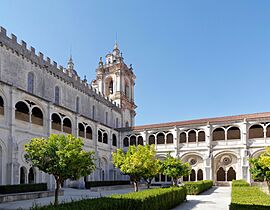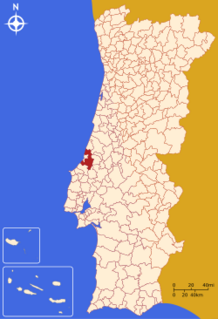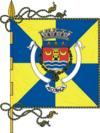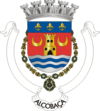Alcobaça, Portugal facts for kids
Quick facts for kids
Alcobaça
|
|||
|---|---|---|---|
|
Municipality
|
|||
 |
|||
|
|||
 |
|||
| Country | |||
| Region | Oeste e Vale do Tejo | ||
| Intermunic. comm. | Oeste | ||
| District | Leiria | ||
| Parishes | 13 | ||
| Area | |||
| • Total | 408.14 km2 (157.58 sq mi) | ||
| Elevation | 42 m (138 ft) | ||
| Population
(2011)
|
|||
| • Total | 53,649 | ||
| • Density | 131.4475/km2 (340.448/sq mi) | ||
| Time zone | WET/WEST (UTC+0/+1) | ||
| Postal code |
2460, 2461, 2475
|
||
| Patron | Saint Bernard | ||
| Local holiday | 20 August | ||
Alcobaça (Portuguese pronunciation: [alkuˈβasɐ]) is a city and a municipality in Portugal. It's located in the Leiria District and is part of the Oeste region. The city gets its name from two rivers, the Alcoa and the Baça, which flow through its valleys.
In 2011, about 56,693 people lived in the Alcobaça municipality, which covers an area of about 408 square kilometers (158 square miles). The city itself has about 15,800 residents.
Alcobaça became famous because of its amazing Monastery of Alcobaça. This huge Gothic building was started by the first king of Portugal, Afonso Henriques. He built it to celebrate his victory over the Moors in 1147. Inside the monastery church, you can find the tombs of King Pedro I and his beloved, Inês de Castro. This monastery was very important in shaping Portuguese culture over many centuries.
Close to Alcobaça, you can find other interesting places. To the north is the Monastery of Batalha, another Gothic building. To the west is Nazaré, a fishing village that is now a popular holiday spot. To the south are the city of Caldas da Rainha and the old town of Óbidos. To the northeast is Porto de Mós with its rebuilt castle.
Contents
History of Alcobaça
Alcobaça became well-known in the 12th century. This was when it was chosen as the place for Portugal's biggest church. In March 1147, the young King Afonso Henriques won a big battle against the Moors at Santarém. To thank for his victory, he promised to build a grand home for the Cistercian monks.
It took 76 years for the main part of this huge building to be finished. Later, King Dinis added the main cloister. The monastery was officially opened in 1262.
The church holds the tombs of King Pedro I and his love, Inês de Castro. Pedro was married to Constanza, a princess from Castile. But he fell in love with Inês and lived with her in Coimbra. His father, King Afonso IV, worried that Inês's family was a danger to his kingdom. So, he had Inês murdered.
After his father died, Pedro said he had secretly married Inês earlier. He then had her body moved to the monastery. Today, their beautiful tombs face each other. This way, on Judgment Day, the first person Pedro sees will be Inês.
For many centuries, the monks from this monastery greatly influenced Portuguese culture. In 1269, they were the first to offer public lessons. They also wrote the first important history books about Portugal. In 1810, French invaders took many treasures from the abbey, including its valuable library. More items were stolen in 1834 during a time when religious groups were banned in Portugal.
Alcobaça's Climate
Alcobaça has a Mediterranean climate. This means it has warm, dry summers and mild, wet winters.
| Climate data for Alcobaça, Portugal, 1981–2010 | |||||||||||||
|---|---|---|---|---|---|---|---|---|---|---|---|---|---|
| Month | Jan | Feb | Mar | Apr | May | Jun | Jul | Aug | Sep | Oct | Nov | Dec | Year |
| Record high °C (°F) | 23.7 (74.7) |
25.0 (77.0) |
29.8 (85.6) |
33.0 (91.4) |
35.3 (95.5) |
40.8 (105.4) |
40.0 (104.0) |
41.0 (105.8) |
39.4 (102.9) |
33.0 (91.4) |
27.9 (82.2) |
24.0 (75.2) |
41.0 (105.8) |
| Mean daily maximum °C (°F) | 15.2 (59.4) |
16.1 (61.0) |
18.6 (65.5) |
19.2 (66.6) |
21.3 (70.3) |
24.4 (75.9) |
26.0 (78.8) |
26.6 (79.9) |
25.6 (78.1) |
22.3 (72.1) |
18.3 (64.9) |
15.8 (60.4) |
20.8 (69.4) |
| Daily mean °C (°F) | 8.4 (47.1) |
9.5 (49.1) |
11.6 (52.9) |
12.7 (54.9) |
14.8 (58.6) |
17.9 (64.2) |
19.6 (67.3) |
19.8 (67.6) |
18.5 (65.3) |
15.4 (59.7) |
11.7 (53.1) |
9.7 (49.5) |
14.1 (57.4) |
| Mean daily minimum °C (°F) | 4.0 (39.2) |
4.9 (40.8) |
6.7 (44.1) |
8.1 (46.6) |
10.2 (50.4) |
13.1 (55.6) |
14.7 (58.5) |
14.6 (58.3) |
13.0 (55.4) |
10.4 (50.7) |
7.2 (45.0) |
5.6 (42.1) |
9.4 (48.9) |
| Record low °C (°F) | −5.9 (21.4) |
−5.7 (21.7) |
−5.2 (22.6) |
−0.5 (31.1) |
1.0 (33.8) |
4.7 (40.5) |
6.1 (43.0) |
5.5 (41.9) |
3.5 (38.3) |
0.2 (32.4) |
−5.6 (21.9) |
−5.8 (21.6) |
−5.9 (21.4) |
| Average precipitation mm (inches) | 107.1 (4.22) |
82.9 (3.26) |
59.9 (2.36) |
80.7 (3.18) |
59.6 (2.35) |
22.7 (0.89) |
8.9 (0.35) |
12.4 (0.49) |
40.3 (1.59) |
104.3 (4.11) |
122.0 (4.80) |
118.5 (4.67) |
819.3 (32.27) |
| Average precipitation days (≥ 1 mm) | 11.0 | 9.4 | 7.8 | 10.3 | 8.1 | 3.8 | 1.6 | 2.0 | 5.1 | 10.2 | 11.1 | 12.2 | 92.6 |
| Average relative humidity (%) | 78 | 76 | 71 | 69 | 68 | 69 | 68 | 67 | 69 | 73 | 77 | 78 | 72 |
| Source 1: Instituto Português do Mar e da Atmosfera | |||||||||||||
| Source 2: Porto de Mós Municipality (IPMA: Humidity) | |||||||||||||
| Climate data for Alcobaça, Portugal (1971–2000) | |||||||||||||
|---|---|---|---|---|---|---|---|---|---|---|---|---|---|
| Month | Jan | Feb | Mar | Apr | May | Jun | Jul | Aug | Sep | Oct | Nov | Dec | Year |
| Record high °C (°F) | 23.1 (73.6) |
25.0 (77.0) |
30.0 (86.0) |
30.0 (86.0) |
34.0 (93.2) |
40.8 (105.4) |
40.0 (104.0) |
38.0 (100.4) |
39.4 (102.9) |
33.2 (91.8) |
26.6 (79.9) |
24.0 (75.2) |
40.8 (105.4) |
| Mean daily maximum °C (°F) | 15.1 (59.2) |
15.8 (60.4) |
18.2 (64.8) |
19.0 (66.2) |
20.8 (69.4) |
23.7 (74.7) |
25.9 (78.6) |
26.2 (79.2) |
25.6 (78.1) |
22.0 (71.6) |
18.4 (65.1) |
15.9 (60.6) |
20.6 (69.1) |
| Daily mean °C (°F) | 9.6 (49.3) |
10.6 (51.1) |
12.4 (54.3) |
13.6 (56.5) |
15.5 (59.9) |
18.4 (65.1) |
20.3 (68.5) |
20.3 (68.5) |
19.3 (66.7) |
16.2 (61.2) |
13.1 (55.6) |
11.1 (52.0) |
15.0 (59.0) |
| Mean daily minimum °C (°F) | 4.2 (39.6) |
5.4 (41.7) |
6.7 (44.1) |
8.1 (46.6) |
10.2 (50.4) |
13.0 (55.4) |
14.7 (58.5) |
14.4 (57.9) |
13.0 (55.4) |
10.4 (50.7) |
7.9 (46.2) |
6.4 (43.5) |
9.5 (49.1) |
| Record low °C (°F) | −5.5 (22.1) |
−5.0 (23.0) |
−3.0 (26.6) |
−0.5 (31.1) |
1.0 (33.8) |
5.5 (41.9) |
6.0 (42.8) |
5.5 (41.9) |
3.5 (38.3) |
0.5 (32.9) |
−2.5 (27.5) |
−4.0 (24.8) |
−5.5 (22.1) |
| Average precipitation mm (inches) | 106.0 (4.17) |
101.7 (4.00) |
59.2 (2.33) |
76.1 (3.00) |
64.8 (2.55) |
23.8 (0.94) |
7.8 (0.31) |
11.8 (0.46) |
36.2 (1.43) |
95.2 (3.75) |
124.9 (4.92) |
132.1 (5.20) |
839.6 (33.06) |
| Average precipitation days (≥ 0.1 mm) | 13.6 | 13.1 | 10.4 | 12.4 | 11.1 | 6.8 | 3.1 | 3.4 | 6.4 | 11.4 | 13.8 | 15.5 | 121.0 |
| Source: Instituto Português do Mar e da Atmosfera | |||||||||||||
Parishes
The municipality of Alcobaça is divided into 13 smaller areas called civil parishes (freguesias):
- Alcobaça e Vestiaria
- Alfeizerão
- Aljubarrota
- Bárrio
- Benedita
- Cela
- Coz, Alpedriz e Montes
- Évora de Alcobaça
- Maiorga
- Pataias e Martingança
- São Martinho do Porto
- Turquel
- Vimeiro
Alcobaça City Highlights
The most important building in Alcobaça is its grand monastery. It has a long, serious-looking front with fancy details from the 1700s. Inside, the cloisters (covered walkways) are very plain, which is why one is called the "Cloister of Silence."
However, the monastery also has a huge kitchen. A special stream was even diverted to flow right through it, providing fresh water! The opening for the kitchen chimney is so big that a whole ox could be roasted there. The entrance to the sacristy (a room for church items) has amazing Manueline style decorations.
Places to Visit Nearby
Just a few kilometers north of Alcobaça, you'll find another amazing building. This is the monastery at Batalha. It was built to remember the important Battle of Aljubarrota in 1385. In this battle, King John I of Portugal defeated the Castilians. This victory helped Portugal stay independent for 200 years. The Batalha Abbey started being built in 1388, and different Portuguese kings added to it over two centuries.
East of Batalha is Fátima, a world-famous place for Roman Catholic pilgrims. Many people visit because three young children saw a vision of the Virgin Mary there in 1917.
To the west of Alcobaça is Nazaré, a well-known fishing village. Today, it's a popular holiday resort. While it has changed a lot, some traditions remain. You can still see locals wearing their special traditional clothes.
South of Alcobaça are Caldas da Rainha and the charming medieval town of Óbidos. Óbidos is a great place for tourists who want to see what the past was like. Also to the south is Porto de Mós with its unique rebuilt castle. This town is next to the Serras de Aire e Candeeiros Nature Reserve. This area has 390 square kilometers of limestone landscape, known for its caves. The most famous caves are the Grutas de Mira de Aire. You can visit them and explore tunnels, caverns with amazing rock formations, and underground lakes.
Major Events in Alcobaça
Alcobaça hosts several fun events throughout the year:
- Market days – Every Monday
- Carnaval de Alcobaça – February/March
- Cistermúsica – a classical music festival – June / July
- Saint Bernard's fair – August 20
- Municipal holiday – August 20
- Marionetas na Cidade – a puppetry festival – mid-October
- Saint Simon's fair – 4th week of October
- International display of Sweets and Conventual Liqueurs – November
Famous People from Alcobaça
Alcobaça has been home to many notable people:
- Joaquim Ferreira Bogalho (1889–1977) – a former president of S.L. Benfica football club.
- Virgínia Vitorino (1895–1967) – a teacher, poet, and writer.
- João Lourenço (born 1942) – a former football player.
- Alberto Costa (born 1947) – a politician who served as the Minister of Justice.
- Nuno Gonçalves – a musician and founder of the band The Gift.
- João Traquina (born 1988) – a Portuguese football player.
- João Pedro Silva (born 1989) – a professional triathlete who competed in the 2012 Summer Olympics.
- The Gift (formed 1994) – a Portuguese alternative rock band.
- Loto (formed 2002) – an electro-pop-rock-dance music band.
- JÜRA – a popular pop artist.
International Friends
Alcobaça is twinned with these cities around the world:
 Aubergenville, France
Aubergenville, France Bełchatów, Poland
Bełchatów, Poland Cacuaco, Angola
Cacuaco, Angola Chicopee, United States
Chicopee, United States
Images for kids
See also
 In Spanish: Alcobaza para niños
In Spanish: Alcobaza para niños








